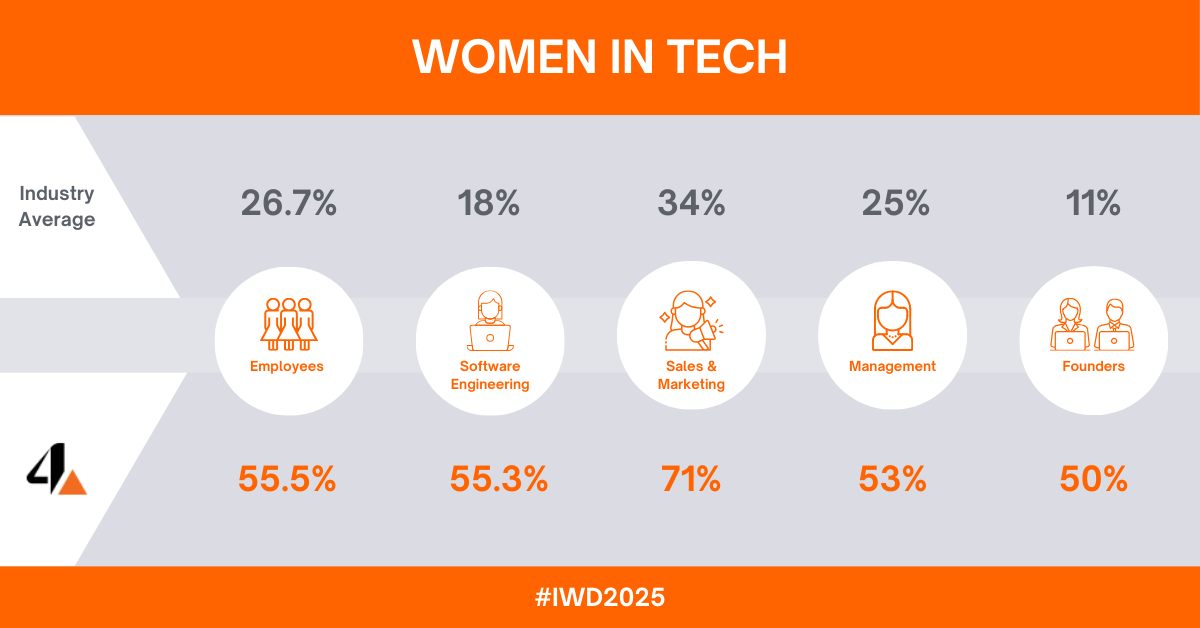International Women’s Day (IWD), observed annually on March 8, serves as a global rally for gender equality, a mission that resonates profoundly within the technology sector. As we mark this day in 2025, we reflect not only on the advancements made by women in tech but also on the systemic barriers that persist. The underrepresentation of women in tech roles—a gap that stifles innovation and economic growth—remains a critical challenge.

This article explores the historical contributions of women in tech and current challenges. We shall conclude with a comparative analysis between industry norms and our own 4PSA team.
A historical lens of women in tech
The narrative of women in tech is one of both breakthroughs and setbacks. During the 1940s and 1950s, pioneers like Katherine Johnson—NASA’s human computer—and the ENIAC programmers laid the groundwork for modern computing, only to be sidelined as the tech industry commercialized.
By the 1980s, women’s representation in computer science peaked at 32 percent according to the National Center for Women & Information Technology (NCWIT, 2022). The percentage of women employed in IT registered a high of 37 percent in 1990-1991 before plummeting to 25 percent by 2009.
By 2019, women held just 26 percent of professional computing roles in the U.S. The overall progress remains slow. And the pandemic worsened attrition, with 41 percent of women in tech considering leaving their roles.
The current landscape
Women currently hold approximately 35 percent of roles in science, technology, engineering, and mathematics (STEM) in the U.S., a figure that has seen only modest growth over the past decade. In the tech sector, men outnumber women by a ratio of 4:1 in technical roles. A persistent gender pay gap lingers, with women in tech earning 21 percent less than their male peers.
Leadership roles reflect similar disparities: women leaders occupy just 25 percent of C-suite positions in tech firms, according to a 2023 McKinsey & Company report.
The attrition rate among women in tech is striking. Half of women leave tech by mid-career, as highlighted in a 2023 Girls Who Code study, with workplace culture and limited advancement cited as key factors. This leaky pipeline not only diminishes diversity but also strips companies of critical perspectives essential for innovation.
Tactics to increase the number of women in tech
To bridge the gender gap in IT, organizations must adopt comprehensive strategies. Begin with education and mentorship programs that engage girls early through STEM initiatives and coding workshops. Partnerships with schools and nonprofits can build pipelines for underrepresented groups, while highlighting female role models inspires the next generation.
Companies should implement inclusive hiring practices and foster inclusive cultures through mentorship programs. Flexible work policies and parental support (like childcare stipends) also help retain women in tech.
There are of course many strategies that can work towards this goal. By addressing systemic barriers and fostering inclusive environments, the IT industry can achieve transformative gender equity.
Our 4PSA team rules!
While the tech industry crawls toward gender parity, 4PSA stands as a trailblazing exception. Our workforce defies industry norms with purpose:
- 55.5% of all employees are women (vs. 26.7% industry-wide).
- 55.3% of software engineers are women, dwarfing the 18% industry average.
- 71% of sales and marketing roles are held by women (vs. 34% in the industry).
- 69% of team support are held by women.
Leadership mirrors this progress. 53 percent of management roles are held by women—proof that the glass ceiling is made to be shattered 🙂
These figures aren’t abstract stats. They are the DNA of 4PSA, a company co-founded by a man and woman 23 years ago. This isn’t progress—it’s a revolution!
On behalf of the entire team, Happy International Women’s Day to all the phenomenal women who inspire us every day!
Post A Reply